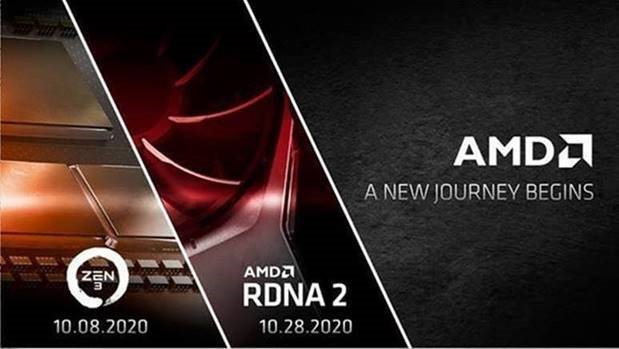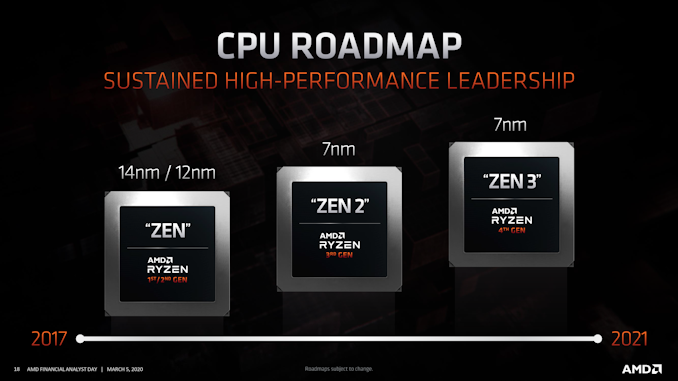AMD Announces Ryzen "Zen 3" and Radeon "RDNA2" Presentations for October: A New Journey Begins
by Ryan Smith on September 9, 2020 5:30 PM EST
AMD today has announced that they will be making a pair of consumer product presentations in October. The chipmaker, who has been fairly quiet since the spring, will be holding events for both their consumer Ryzen CPU and Radeon GPU product segments. Dubbing the events “A New Journey Begins”, the company will be announcing the first products based on their eagerly anticipated Zen 3 CPU architecture and RDNA 2 GPU architecture.
Leading the charge will be AMD’s CPU division. On October 8th at noon Eastern, the company will be presenting their Zen 3-based Ryzen desktop processors. AMD’s CEO, Dr. Lisa Su, will be among the presenters.
Following that up just under 3 weeks later will be AMD’s Radeon presentation, which again is at noon Eastern. There the company will be showing off its first products based on the company’s forthcoming RDNA 2 GPU architecture. Meanwhile, tipping their hand a bit early on naming, AMD has confirmed that this will be called the Radeon RX 6000 series.
Next Generation Ryzen Desktop Processors – 10/8, 12 p.m. ET
We are incredibly excited to invite you to learn more about the next wave of Ryzen desktop processors with “Zen 3” architecture, taking our PC gaming and content creation leadership to new heights. Dr. Lisa Su and other AMD senior executives will kick-off this new journey for “Zen 3” and AMD Ryzen at 12 p.m. ET, October 8th.
Next Generation Radeon Graphics – 10/28, 12 p.m. ET
Preparing to delight gamers globally with the next horizon of Radeon Graphics, we invite you to learn more about our RDNA 2 architecture, Radeon RX 6000 series graphics cards, and our deep collaboration with game developers and ecosystem partners who will help us bring the best of Radeon to gamers. Tune in for the reveal of the future of Radeon PC gaming at 12 p.m. ET, October 28th.
AMD hasn’t disclosed any other details about these events at this time, but over the last several months the manufacturer has shared bits and pieces of information relating to its upcoming chip architectures. Based on AMD’s roadmaps, Ryzen Zen 3 processors will be built on an improved version of TSMC’s 7nm process, most likely TSMC’s N7P process given AMD’s comments clarifying that they aren’t committing to EUV for 7nm. Otherwise, for the moment AMD is remaining tight-lipped on the Zen 3 architecture itself, though given that AMD isn’t going to get the benefits of a full node shrink, we’re expecting Zen 3 to deliver some interesting and meaningful architectural improvements over Zen 2.
Meanwhile on the graphics front, AMD and partners have previously confirmed that RDNA 2 will be a DirectX 12 Ultimate (feature level 12_2) compliant GPU architecture, meaning that AMD will be making significant changes to the graphics side of their GPU designs. The Navi 2x family of GPUs will gain support for ray tracing, variable rate shading, and other features that will put AMD’s new GPUs at parity with the competition, both for consoles and PCs. Meanwhile from a performance standpoint, AMD is aiming for a hefty 50% jump in performance-per-watt, which could potentially eliminate the efficiency gap with NVIDIA. As well, the company has previously promised a high-end "top-of-stack" GPU for 4K gaming, so we're expecting some ambitious performance goals from AMD.
Be sure to check in on October 8th and October 28th for more details on AMD’s next generation of consumer parts!
It’s going to be an exciting fall for gamers... time to start a new journey with @AMDRyzen Zen3 and @Radeon RDNA2 pic.twitter.com/O9SXvLo4y0
— Lisa Su (@LisaSu) September 9, 2020
Source: AMD












143 Comments
View All Comments
Falloutboy - Saturday, September 12, 2020 - link
X570 will prolly be the last high-end chipset for this platform.shaddixboggs - Wednesday, September 9, 2020 - link
well dude, can't you just set an alarm if it stops spinning and replace it?wr3zzz - Wednesday, September 9, 2020 - link
You fan-is-no-big-deal people fail to understand that the fan is never the disease, it's a symptom. That the MB needs a fan means there are excess heat which means the circuits and components are under more duress which means there are more potential points of failure.SaturnusDK - Thursday, September 10, 2020 - link
And what you fail to understand is that the fan on x570 boards is pure precautionary. It's not in use for 90% or more of regular use cases on most boards. It's only needed if you have several PCIe 4 devices, ie. more than just a graphics card and one/two NMVe.On top of that there's fail guards and temperature sensors in practically all modern ICs.
wr3zzz - Thursday, September 10, 2020 - link
Then why don't you remove that little tiny fan if it's not a big deal? No? Then stop belittling people who prefer a chipset that doesn't need to be actively cooled.Dizoja86 - Thursday, September 10, 2020 - link
wr3zzz is feeling oppressed over what's pretty much the most first-world problem in existence.shabby - Thursday, September 10, 2020 - link
Bet you $5 that Intel's pcie4 chipset will also need one... whenever that comes out 🤷🏼♂️Qasar - Thursday, September 10, 2020 - link
considering i have never heard my x570 chipset fan at all, i doubt it has even spun for more then a few seconds, even while there is any load on the system, so no need to remove it :-)Spunjji - Friday, September 11, 2020 - link
Invert your logic: why remove it when it does no harm to be there, and ensures system stability in edge-cases?You're transparently trying to work backwards from a preference to a "rational" justification for it, which is the opposite of rationality.
Spunjji - Friday, September 11, 2020 - link
Deciding you don't want a fan is a personal choice - an opinion - and that's all well and good. Hand-waving a bunch of specious nonsense to justify that opinion, though - well that's just silly, because now we know you're full of it.If you were talking the difference between 50W and 100W to dissipate, you might have a point. 4-10W, not so much:
https://hexus.net/tech/news/mainboard/132515-der8a...